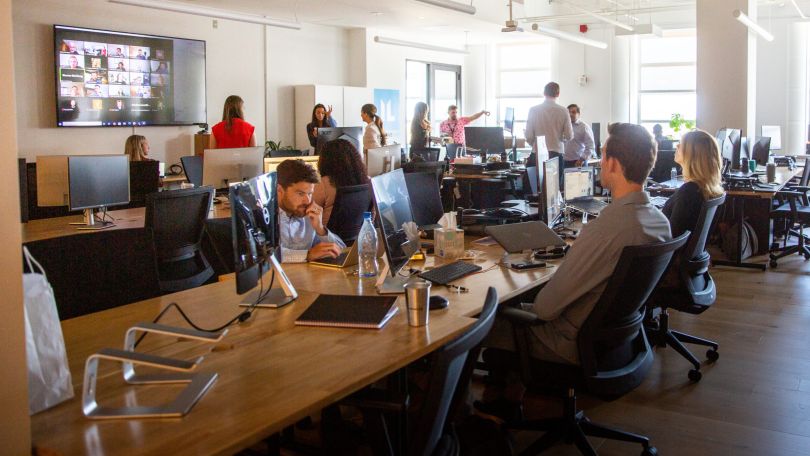For customer success managers tasked with the crucial responsibility of guiding and fine-tuning the client experience, there will always be an element of reactiveness.
Client relationships are always developing, from their changing business strategies to figuring out how they can use a company’s offerings more effectively.
In short, there’s a lot going on.
But to act proactively and predictively, CSMs look to tried-and-true methods that make things run smoother. Rapid7’s Principal CSM Courtney Arrigg said a “trust, but verify” approach and regular touchpoints with her customers are critical to staying ahead of the curve and in tune with customers’ needs. Meanwhile, Immersive Labs’ Manager of Customer Success Brandon Challener relies on a data-driven strategy to track progress and demonstrate wins.
With more technological tools available than ever before, CSMs are finding new ways to be more proactive with clients. Still, some strategies that have been around for years remain as useful today as they were a decade ago.
Built In Boston reached out to these two professionals to learn what tools and tactics they leverage to stay proactive.

Cybersecurity and network security company Rapid7’s Insight Platform provides organizations with tools to investigate and detect malicious threats, automate operations and more. The company is one of Built In’s Best Places to Work in 2023.
What’s one personal habit you’ve adopted that’s helped you be more proactive as a CSM?
For my most successful customer partnerships, I’ve found that setting a consistent engagement cadence with my customers has been an incredibly valuable habit to adopt. By proactively reaching out to my customers on a regular basis, I’m able to identify both opportunities and challenges in a timely manner and work toward finding solutions.
I make it a habit to schedule biweekly calls with each of my key customers. I’ll kick off the call by asking about any updates or pressing issues my customers are facing. From there, we’ll review any outstanding action items, Rapid7 updates or new product functionality that I think may be beneficial to support their program. Finally, we’ll cover any strategic initiatives they are focused on to identify areas we can lean in with additional resources or potential growth opportunities.
By maintaining regular touchpoints with my customers, I am able to catch and address potential issues early. This has helped to build trust with my customers and strengthen our partnership. They appreciate the consistency and predictability of these touchpoints, which has led to a stronger working relationship overall.
What role does data play in helping you and your team be more proactive in your approach to customer success?
Rapid7 has invested heavily in providing the customer success team with more insight into customer patterns and trends, enabling us to take a more proactive approach to serving customers.
I have always been a firm believer in “trust, but verify,” and I rely on our insights to guide my conversations with customers. Before my cadence calls, I will review any changes in usage data and support metrics to see if there are any key areas we need to focus on.
For example, if I see concerning product usage trends, I will proactively address this to identify if this is a sign of risk, a result of a technical issue they are experiencing or a temporary shift. Depending on the customer feedback, I can then loop in the appropriate internal resources for assistance.
Using the trends and metrics helps identify potential problems before they escalate and ultimately provides a better customer experience.
If I see concerning product usage trends, I will proactively address this to identify if this is a sign of risk, a result of a technical issue they are experiencing or a temporary shift.”
As a team, what’s a system or strategy you’ve put in place to get ahead of potential issues before they arise? What other teams, if any, help support this strategy?
Our focus at Rapid7 has been on enhancing customer engagement through team collaboration. We believe that the more closely we align, the better the customer experience will be.
Depending on the customer, we may have multiple team members assigned to the account, including CSMs, account executives, customer advisors and technical account managers. To ensure that we’re providing a unified experience, we schedule monthly internal syncs or keep active Slack channels for any key updates.
Oftentimes customers will share different slices of information with us. They may tell support that a feature is broken, but they provide the CSM with the full business impact this is causing them internally.
By staying aligned internally, we can put together a full picture of a customer environment, challenges, goals and opportunities to improve. The additional context different team members provide helps us to identify potential issues that need action taken or to effectively escalate them to our product or engineering teams.
By leveraging the expertise and resources of each team member, we are able to deliver a better customer experience and proactively identify and address potential issues before they arise.

Immersive Labs, one of Built In Boston’s Best Places to Work in 2023, helps organizations with their cyber workforce resilience via realistic simulations and hands-on cybersecurity labs.
What’s one personal habit you’ve adopted that’s helped you be more proactive as a CSM?
I’ve been working in client-facing roles my whole career, so I’ve adopted different habits to ensure my clients receive meaningful communications from me at important touchpoints. One of the most important processes we’ve adopted here at Immersive Labs is the use of in-platform customer intelligence and communications. This helps us highlight health metrics, ensuring that our customers are using our platform optimally to achieve their business goals.
I start my day by taking a moment to better understand customer needs and ensure we’re delivering on their key business outcomes, such as improving their cyber capabilities or their speed and quality of response to cyber threats. I find that having an actionable dashboard helps me do this.
Understanding customer needs, and following up in a timely manner to drive value, are skills I’ve honed at Immersive Labs. Just reaching out to someone isn’t good enough; you need to ensure all communications stay ahead of their requirements. Whether it’s teasing a new feature or recognizing something that can help a customer strive towards the goals that they stated, I’ve learned how crucial well-timed communications with a strong message are.
Just reaching out to someone isn’t good enough; you need to ensure all communications stay ahead of their requirements.”
What role does data play in helping you and your team be more proactive in your approach to customer success?
Data are absolutely critical to my role at Immersive Labs. By leveraging data, the team and I can be more impactful in our actions and communications. Data helps me measure whether my clients are on the right path to achieving their key business outcomes and make course corrections to make sure we’re on track.
Having strong metrics available for clients makes it easier to talk strategically during recurring check-ins. This allows us to spend time talking through our strengths and areas of opportunity. Part of being a CSM is being a coach and celebrating wins is a lovely way to build a strong relationship, but how can you do that effectively without strong data demonstrating those wins?
As a team, what’s a system or strategy you’ve put in place to get ahead of potential issues before they arise? What other teams, if any, help support this strategy?
Immersive Labs has grown tremendously since I joined two years ago. With this growth, we’ve evolved and enhanced our existing processes to match new ways to succeed with our clients. One of the obvious contributors to that is that data should be a huge factor in any system or strategy. Business questions can be answered by using data and by monitoring trends.
Even if the issues aren’t data-driven and instead are something more subjective, like a change in champion or a quick mention related to bandwidth or budget, it’s crucial to have a #oneteam mentality. Immersive Labs has a “customer obsessed” mantra, so everyone is ready to jump in to ensure the customer is working towards delivering strong value.
This can range from our account management team highlighting strong customer stories, to our product and content team highlighting how customer feedback can be incorporated into our roadmap. Specifically, our product team joins executive business reviews that I hold to talk about client insights directly. Customers want their voices to be heard, so having more technical teams join to talk through specific feedback is a best practice that we employ.









